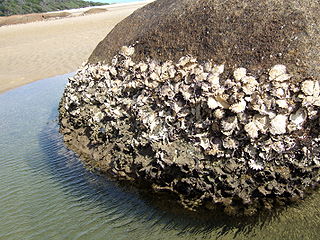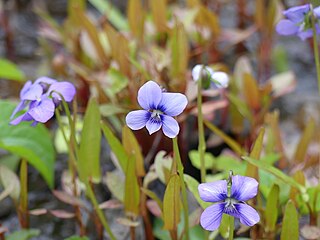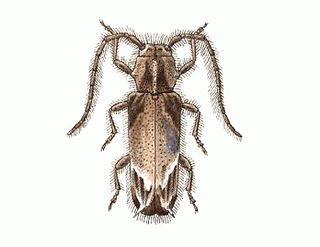
Saccostrea glomerata is an oyster species belonging to the family Ostreidae.
The Field Elm cultivar Ulmus minor 'Concavaefolia' was briefly described by Loudon in Arboretum et Fruticetum Britannicum (1838), as Ulmus campestris var. concavaefolia. A fuller description followed in Petzold and Kirchner 's Arboretum Muscaviense (1864). Henry noted that Loudon's "insufficiently described" U. campestris var. concavaefolia seemed to be identical with the field elm cultivar 'Webbiana', a view repeated by Krüssmann.
The Field Elm cultivar Ulmus minor 'Cucullata', the Hooded elm, was listed by Loddiges of Hackney, London, in their catalogue of 1823 as Ulmus campestris cucullata, and later by Loudon in Arboretum et Fruticetum Britannicum (1838), as U. campestris var. cucullata.

Viola cucullata, the hooded blue violet, marsh blue violet or purple violet, is a species of the genus Viola native to eastern North America, from Newfoundland west to Ontario and Minnesota, and south to Georgia. It is a recipient of the Royal Horticultural Society's Award of Garden Merit.

The hooded berryeater is a species of bird in the family Cotingidae. It is endemic to Brazil.

The hooded treepie is a species of bird in the family Corvidae. It is endemic to Myanmar.

The azure-hooded jay is a species of bird in the family Corvidae. It is found in Middle America. Its natural habitat is subtropical or tropical moist montane forest. This species is known to have four subspecies. It is 11 to 12 inches in length and is dark blue with a black head and upper chest. The back of the head and neck are sky blue with a white border.

The hooded robin is a small passerine bird native to Australia. Like many brightly coloured robins of the Petroicidae, it is sexually dimorphic; the male bears a distinctive black-and-white plumage, while the female is a nondescript grey-brown.

Desmiphora is a genus of longhorn beetles of the subfamily Lamiinae, containing the following species:
Desmiphora neoflavescens is a species of beetle in the family Cerambycidae. It was described by Galileo and Martins in 1998. It is known from Brazil.
Desmiphora santossilvai is a species of beetle in the family Cerambycidae. It was described by Galileo and Martins in 2003. It is known from Brazil and French Guiana.
Desmiphora auatinga is a species of beetle in the family Cerambycidae. It was described by Martins and Galileo in 1996. It is known from El Oro: Machala Ecuador.

Desmiphora canescens is a species of beetle in the family Cerambycidae. It was described by Henry Walter Bates in 1874. It is known from Colombia, Mexico, and Venezuela.
Desmiphora picta is a species of beetle in the family Cerambycidae. It was described by Stephan von Breuning in 1943. It is known from Argentina.
Desmiphora maculosa is a species of beetle in the family Cerambycidae. It was described by Linsley and Chemsak in 1966. It is known from the Galapagos Islands.
The Field Elm cultivar Ulmus minor 'Cucullata Variegata', a variegated form of U. minor 'Cucullata', was listed by C. de Vos, in 1867, as U. americana cucullata folia variegata and by Schelle in Beissner Handbuch der Laubholz-Benennung, 82 (1903) as U. campestris concavifolia cucullata variegataHort, without description.
The Wych Elm cultivar Ulmus glabra 'Grandidentata', listed as U. glabra var. grandidentata (Moss), may have been the tree first described by Dumortier in Florula Belgica, 25, 1827, as U. corylacea var. grandidentata, in cultivation before 1830. Green thought it a synonym of 'Cornuta'. 'Grandidentata' may be synonymous with U. glabra 'Corylifolia', which Green thought another synonym of 'Cornuta'.

The Wych Elm cultivar Ulmus glabra 'Concavaefolia', a form with up-curling leaves, was listed in Beissner's Handbuch der Laubholz-Benennung (1903) as Ulmus montana cucullataHort. [:'hooded', the leaf], a synonym of the Ulmus scabraMill. [:glabraHuds.] var. concavaefolia of herbarium specimens. An Ulmus campestris cucullata, of uncertain species, had appeared in Loddiges' 1823 list, but Loudon's brief description (1838) of concave- and hooded-leaved elms was insufficient for later botanists to distinguish them. The earliest unambiguous description appears to be that of Petzold and Kirchner in Arboretum Muscaviense (1864).

Hemipilia cucullata is a species of flowering plant in the family Orchidaceae, native to temperate Eurasia from Poland to Japan, and also to the Himalayas. It is terrestrial, growing from tubers, to a height of up to 30 cm, with pinkish flowers arranged in a one-sided spike. It was placed in several different genera before being placed in its present genus.

Begonia cucullata, also known as clubbed begonia, is a species of the Begoniaceae that is native to South American countries of Argentina, Brazil, Paraguay, and Uruguay. A common garden plant and part of the section Begonia, it was described in 1805 by Carl Ludwig Willdenow (1765–1812). The specific epithet "cucullata" means "resembling a hood" or "hooded".










